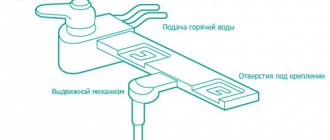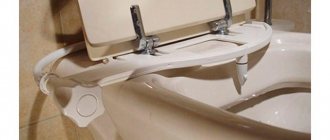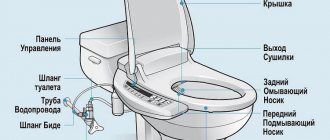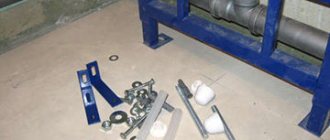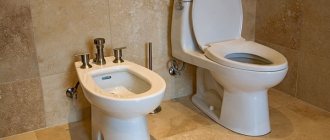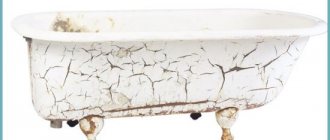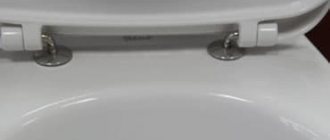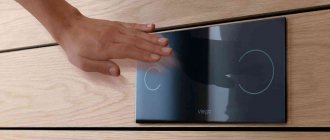“Hygiene is above all” - this wisdom has been repeated for more than one century and, fortunately, the relevance of this statement does not go away. Especially if it's intimate hygiene.
It is thanks to the desire to maintain hygiene that the bidet is gaining more and more popularity every day. However, for some people, the installation of such a unit still causes confusion: “Why is it needed if there is a bathtub and a regular toilet? And how to use a bidet?
Bidet - what kind of device is it?
A bidet is a device that belongs to the category of plumbing fixtures. Outwardly, it is similar to a toilet, but its function is the opposite: it helps to maintain hygiene after visiting the toilet (carrying out the act of defecation and relieving minor needs).
Some types of bidets are designed both as a toilet and as a small bathtub for washing the genitals.
The history of the discovery of the bidet
The bidet was first mentioned in the 17th century in France. The word “bidet” itself comes from “le bidet”, which means “little grasshopper”. This is probably due to the design it had in ancient times.
Then it was a small bathtub filled with water, placed on a small table. In those days, this device had a reputation as a “device for courtesans,” but even Louis XVI recognized this device as useful and necessary, and used it himself.
How does a bidet work?
Along the perimeter there are nozzles from which jets of water are supplied under high pressure to thoroughly wash the genitals. The entire procedure is designed to prevent the occurrence of diseases of the urethra, sexually transmitted diseases, and sexual diseases.
It is worth paying attention to the need for this device for people suffering from hemorrhoids. In addition to the massage effect, a person also gets the opportunity to maintain hygiene, since with this disease, toilet paper irritates the organ.
Why and for whom is a bidet needed?
The function of a bidet is to carry out hygiene procedures immediately after visiting the toilet. Of course, an adult and healthy person can carry out this procedure in the bathroom, but people whose capabilities are limited, as well as elderly citizens, cannot carry out hygienic procedures to the fullest extent. This hygienic shower makes life easier and is also useful for washing babies.
Another function of a bidet is to help with housework. If the set includes a shower head, then using a bidet you can clean the toilet, fill containers, and wash trays.
The main advantage of a bidet is its wide range of functions, as well as ease of use.
The only problem that may arise is the limited area. However, this problem can be solved by purchasing a toilet and bidet in one device, i.e. a combined option.
It is worth noting that in a bidet it is allowed to carry out hygiene not only of the genitals, but also to wash the feet. If necessary, you can steam your feet in case of illness or for cosmetic procedures. To do this, you need to use a special plug that plugs the outflow of water. After this, it must be carefully processed.
What types of bidets are there?
Before you begin to understand how to use this unit, you need to understand the design. There are two types of bidets: manual and automatic.
- Manual (mechanical)
You will have to adjust the water jet and its temperature yourself.
- Automatic
This bidet has a control unit. The device is controlled using a remote control. Such devices combine a thermostat that heats the water and controls its pressure, adjusting to the set values.
Additional options
A bidet is a multifunctional device, so it can combine the following capabilities:
- heating water;
- water massage;
- drying, i.e. eliminating the need to use a towel;
- light supply;
- possibility of heating the seat.
Terms of use
What is a bidet for and how to use it? A photo of the device allows you to understand how it is used. To wash, it is not necessary to sit on the bath facing the faucet. On the contrary, it all depends on how comfortable it is. The device is convenient for personal hygiene of people, and all people can use it.
What else is a bidet used for? In addition to its main purpose, it is used for washing feet. Many people use it to bathe small children. In this situation, it will serve as a stand for draining dirty water, since it will replace the bathtub. The device is convenient for people with disabilities. Why do girls need a bidet? It serves for personal hygiene to always feel comfortable.
Dimensions
There are options both for spacious rooms, where large plumbing fixtures look better, and miniature ones - for small bathrooms. In the standard version, bidets have the following dimensions: width from 330 to 400mm, height for floor-standing models - 400mm, slightly smaller for wall-mounted ones - 300mm, depth - 520-560mm.
When installing a bidet, the distance between the device and the toilet is taken into account, which depends on the spaciousness of the bathroom. According to the standards, the distance from the edges of the bidet and toilet is 300-450mm, along the axes - 600-900mm.
Why should you install a bidet at home?
Previously, bidets were a luxury, because they could be found in expensive hotels. For many years, people refused to pay attention to this type of plumbing, and in vain. In Europe, Central Asia, and Japan, bidets are so common that they are even installed in public toilets.
The bidet is a quick way to maintain personal hygiene in the groin area.
Excellent bidet model price/quality
The floor-standing bidet Blanc consists of a pedestal and a bowl with two holes - for the drain and for the mixer. Made from hygienic glazed porcelain, which has low water absorption. Thanks to its compact dimensions (WxHxD - 34.4x39.3x50 cm), the bidet is suitable for small bathrooms. Traditional white color matches any interior design.
- The bidet does not change color and remains snow-white throughout its service life.
- “Invisible” installation with hidden fasteners.
- Durability: ceramics are guaranteed for 15 years.
Lots of positive feedback. Bestseller! Find out more and order >>>
Need for a bidet
A bidet is a small bathtub or low sink equipped with a siphon and shower. This type of plumbing was developed by the French. It is installed in the bathroom, mainly near the toilet and serves to maintain personal hygiene.
A stream of water is directed to the genitals and allows you to keep them and the anus clean after visiting the toilet. The bidet has warm and cold water. In simple designs, the temperature is regulated by a mixer. Water is supplied from below by a fountain.
Bidet device diagram.
In fact, you need a bidet not only for this, because with its help it is convenient to wash your feet. People with disabilities can use it for regular hygiene.
Small bathrooms in small apartments did not allow the owners to place an additional piece of plumbing, as the premises needed to be remodeled. This also influenced the attitude towards this device as interfering and unnecessary.
An important question is how exactly to fit on this device. It is a mistake to believe that you must sit facing the wall. Many argue that standing with your back to the faucet is more comfortable.
In this case, the device has touch control, which allows you to set the water temperature and procedure time. A stream of water comes from under the toilet lid. After the hygiene procedure, the air flow will help you stay dry. By the way, back in 1980 the Japanese started thinking about developing this type of plumbing for the bathroom.
Basic elements of a bidet cover.
Based on the type of mounting, bidets are distinguished:
- floor - standard, when the outlet pipes are visible;
- wall-mounted - all pipes are hidden behind the panel.
Don't think that a bidet replaces a bath or shower. Of course not. People who use bidets perform water treatments just like everyone else, perhaps a little less often.
An alternative to a bidet is a hygienic shower, which is installed near the toilet. This is a simple design that consists of a mixer and a shower. However, a bidet is more functional than a hygienic shower.
As for hospitals, the installation of such a device is simply necessary for maintaining personal hygiene by the patients of the institution. A common misconception is that bidets are an exclusively feminine type of plumbing fixture. This is not true, men use it too.
Advantages and disadvantages
Having a bidet in the bathroom provides residents with a number of benefits:
- The ability to wash the genitals after going to the toilet, which significantly increases the level of hygiene of the genitals and anus.
- Saving time on the need to use a shower or bathtub to wash individual parts of the body.
- Save time on cleaning large plumbing fixtures after frequent use.
- An opportunity for young children to independently perform basic hygiene procedures.
- Children's use of equipment for various games (launching boats, sea battles, etc.).
- Significant simplification of hygiene procedures for the elderly and disabled.
- Availability of a large selection of models and configurations.
- Availability of additional functions for electronic models (heated seat, control panel, automatic deodorant, cleaning system, antibacterial coating, etc.).
- Practicality, functionality, durability of quality models.
- Easy to install and operate.
- A way to show your wealth.
Bidets also have their disadvantages:
- The need for renovation work in the bathroom (water supply, etc.).
- It is impossible to install a conventional bidet in small rooms, since the equipment takes up space and must be placed next to the toilet.
- The need to install a socket for electronic models.
- Mechanical lids lack additional functions and the ability to regulate water temperature, which can lead to burns, especially for children.
- Lack of service centers for most inexpensive conventional models.
- Significant cost of electronic models.
- Portable options are inconvenient to use.
Kinds
The simplest type is considered to be a small bathroom integrated into a chair. Then designs with a fountain began to be produced for ease of use. This product has become a classic, but there are other types:
- "Paperless toilet" - a bidet placed in the toilet was released in Japan.
- Bidet lid - the device has become popular in Russia. The pipe with the sprayer is installed in the toilet lid.
Some devices are equipped with air dryers to remove moisture from the skin. There is also a heated seat, temperature and water pressure control. There are devices with the function of eliminating unpleasant odors. There are bidets for men and women. Is such a distinction necessary for this? This is due to the anatomical characteristics of the sexes.
Multifunctional seat
Another practical alternative to the classic bidet is the bidet seat (aka bidet lid), which often costs significantly less than a bidet toilet. It is installed on almost any modern toilet instead of a seat, does not require complex installation and, after connecting to cold water and electricity (220 V), turns a standard device into a modern device with many functions. Unlike a shower toilet, a bidet lid is a separate and independent device that adapts to a previously installed toilet. Finally, replacing a toilet will not require a large investment (as well as repair work).
Manufacturers offer various models of bidet lids. The simplest and most affordable mechanical lid includes a faucet installed on its back, near the toilet tank, and a fitting for ablution, which must be cleaned manually, like the toilet bowl.
Bidet lid model TCF4731. Photo: Toto
Automated units are similar in functionality to shower toilets. They are equipped with an electronic control unit, an element that heats the supplied water and is located under the lid, so it is slightly thicker than usual and raised at the back.
If you are going to install a toilet with a powered bidet lid, provide an outlet close to the toilet. Wiring can be laid hidden, as well as openly in a cable channel.
Multifunctional bidet lid Tuma Comfort: shock-absorbed closure (microlift), quick removal system, automatically activated odor removal system, built-in seat heating with presence sensor, WhirlSpray washing technology, various types of jets, pendulum movement of the nozzle. Photo: Geberit
Price
Automated bidet lids are offered by Blooming, Toshiba, Panasonic, Geberit, Duravit, Roca, Jacob Delafon, YoYo, etc. Simple devices will cost approximately 7 thousand rubles. The price of an automated bidet lid starts from 20–50 thousand rubles.
Benefits of a bidet lid
- Easily adapts to a previously installed toilet without requiring any major renovations in the bathroom.
- Unlike shower toilets, they are easy to dismantle (for example, when moving to another apartment).
- It has almost the same advantages as a shower toilet, but costs much less.
Combination rules
You can determine whether the lid model fits your toilet using two parameters. The first is technical: do the mounting holes match those on the toilet (as a rule, the center distance is standard). Compatibility can be found in the special table included with the cover model. It lists many of the models presented on the Russian market. The second is visual compatibility: for example, you cannot put a rounded lid on a square toilet: it does not look very attractive and is inconvenient to use. Some companies that produce bidet covers, for example Geberit, Villeroy & Boch, Roca, offer them in tandem only with toilets of their own production.
Installation and connection
Unlike a conventional toilet, to which it is enough to supply only water and drain into the sewer, an automated device that provides hygiene procedures is connected to the electrical network using a cable. In this case, the following rules must be observed: grounding, RCD, power supply branch separate from all wiring. The console shower toilet is installed, like a regular toilet of this type, using a special installation module.
Using a watering can you can rinse the toilet more thoroughly. Photo: Grohe
How to use a bidet
Several decades ago, such a concept as a “bidet” was unfamiliar to Russian users.
Today, this plumbing equipment is installed in apartments, houses, hotels, and medical institutions.
Its main purpose is to create comfortable conditions for hygiene procedures. In addition, a floor-standing bidet can transform the interior of a restroom, being part of a luxurious ensemble.
Bidet culture in different countries
A plumbing product that looks like a toilet has been actively used for many years in the following countries:
- France;
- Italy;
- Spain;
- Greece;
- Argentina;
- Uruguay.
The product is also popular in some Asian countries. Thus, in Japan, floor-standing bidets can be found in every home. They are distinguished from European ones by a variety of additional functions.
To save space, the Japanese choose products combined with a toilet. They are equipped with special tubes for washing. Some models dry intimate parts of the body. They are fully automated.
Classic products are common in Europe and Russia.
Bidet combined with toilet
Rules of use for women
If you are planning to buy a floor-standing bidet in Moscow,
then you should know about the basic rules for its use:
- The bidet is designed for washing intimate parts of the body. For this reason, it should be used after using the toilet.
- The user's pose can be anything. Initially, the models of this plumbing fixture had a narrowed shape, so it was more convenient to perform the procedures in the form of a “rider” facing the mixer. The modern selection of products involves various shapes, and therefore the pose can be anything.
- A bidet is not a substitute for a shower or bath. This plumbing helps keep only the lower part of the body clean. It is indispensable for people with gastrointestinal diseases, recurrent hemorrhoids, and also during the rehabilitation period, when other water procedures are unavailable.
- The bidet, like other elements of the bathroom, requires timely cleaning. Thanks to the fact that manufacturers use modern materials and technologies in production, the cleaning process is greatly facilitated. The surface of the product does not absorb dirt, and therefore to remove it it is necessary to use a special detergent and brush.
The right choice is the key to pleasant operation
Buying a floor-standing bidet in Moscow will not be a problem. Many stores offer a huge selection to choose from. However, not everyone is ready to vouch for the quality of the products.
Product prices vary depending on the brand and device characteristics. If you wish, you can purchase a set - a bidet and a toilet in the same style and color scheme.
Call us now to buy the best plumbing fixtures!
Bidet cost – choose the best option
The cost of porcelain and earthenware differs greatly, since earthenware is a higher quality material. Earthenware has no pores, which is why odors, moisture, and dirt do not penetrate into it. Thanks to these positive qualities, the device lasts more than 50 years. However, treatment aimed at eliminating harmful organisms should not be carried out.
The cost of wall-mounted and floor-mounted bidets does not differ much. On average, the price of this hygienic shower ranges from two to two hundred thousand. The more functions a bidet has, the more expensive it costs.
However, when purchasing, you should also take into account the installation price and the cost of the work of a plumber. In this case, the payment depends on the complexity of the installation.
A bidet is a device that can be used both for hygiene procedures and for household needs. It differs in structure, materials, location and functions, thanks to which the seat can heat up, change the water pressure and its temperature. Developers are trying to expand the range of bidet capabilities to provide people with comfort and convenience.
The purchase of such a device is not necessary for people who can freely use the bathroom, i.e. their movements are not limited.
However, using a bidet reduces time and also allows you to maintain hygiene more often and better, since toilet paper can carry an infection of the external genital tract inside, which leads to the development of the disease. In addition, a bidet is necessary for disabled people and elderly people, because self-care is more difficult for such people.
It is also worth remembering to use additional hygienic detergents. For example, soap or intimate gel. It is worth paying attention to the choice of towels. It is advisable that it be disposable, since harmful microbes and fungi may remain on the fabric.
The main thing is not to forget to carry out disinfection procedures to eliminate harmful microbes, viruses, infections, as well as eggs of helminth parasites. And then the use of this unit will only bring benefit and comfort.
How to choose
It was found out how the bidet is used and what it is needed for. The convenience of this device is appreciated by many people. That's why they install it in their bathroom. What to choose depends on the stage of bathroom renovation. If the toilet has not yet been installed, then it is advisable to buy an option with an integrated bidet. It is more convenient to use, does not take up much space, and is also equipped with additional functions.
If the toilet has already been installed, then if there is free space, you can install a separate device. This is considered a classic option. In addition, the device will be more functional.
The most affordable option would be to purchase a bidet cover when the toilet is installed and there is no space nearby. Although such a device is not very convenient compared to the classic one, it still performs the functions necessary for a person.
Why a bidet?
No hygiene product can completely replace water for a person. Only with its help can truly ideal cleanliness of the body be achieved. In reality, toilet paper does not provide the same cleansing effect as a bidet.
Using such a device, it will be possible to constantly keep intimate areas clean, as well as get rid of various types of harmful bacteria.
Bidet
In appearance, a bidet is largely reminiscent of a toilet. As for the functional side, a comparison with a bathtub or sink would be more relevant here, since the basic function of a bidet is washing. This is a fairly convenient device because it can be used in a number of situations.
Story
The bidet became common in the 17th century in France, where it was invented. The first devices were noticeably different from the current ones, but their functions were the same. The device became popular in the world in 1990. Japan became the distributor of the fashion trend.
Then the bidet began to be used in many European countries. Nowadays it is found in almost every bathroom, which allows you to constantly maintain hygiene. It became so common that it was installed in schools, hospitals and hotels.
In Russia in the 1990s, it was more difficult to install a bidet, since most rooms were not spacious enough. This required expanding the bathroom, as well as remodeling the bathroom. This procedure is quite expensive, so not everyone can afford it. Now many apartments are being built with a different layout, which allows for additional plumbing.
Types of bidets
There are many designs and shapes of bidets. The simplest and most common option is a faience tank, which is filled with water through a mixer. If necessary, the drain hole can be closed with a plug. In such a device, water is supplied from the bottom up from the nozzle. In some more expensive bidet models, due to the rotation of the nozzle head, it is possible to change the direction of the water jet.
In addition to classic models, there are devices combined with a toilet. These are modern high-tech toilets with built-in bidet capabilities. Such a plumbing device has an electronic control unit for the tips. As a rule, there are two such tips - one of them is longer and the other is shorter. The one that is shorter is suitable for both women and men. In turn, a longer tip is intended for women, since it is maximally adapted to their body structure.
If you decide to purchase a bidet, it is better to give preference to the most well-known and time-tested brands. Then you can be guaranteed to receive the cleanliness and comfort of a quality product that meets the needs of all members of your family.
bidet how to use
Many people who see a bidet for the first time do not understand how to use it correctly. Essentially, this product with a small tap is designed for personal hygiene. Such equipment is mounted directly next to the toilet. Sometimes a dryer is included, so you don't have to use toilet paper.
Which bidet to choose
First of all, you should pay attention to the material from which bidets are made. They can be made of plastic, glass, steel or precious metals. The most common items are made of porcelain and earthenware.
- The highest quality material is porcelain, since it is not porous, and therefore is able to minimally absorb odors, dirt and moisture. Porcelain products can last up to fifty years.
- Since earthenware has a looser structure, it is covered with glaze. Due to this, the service life of earthenware products is about thirty years.
The technology for manufacturing porcelain plumbing fixtures is more expensive, so there is a significant cost difference between earthenware and porcelain products. Naturally, porcelain bidets are not cheap at all.
Secondly , the product must match the size of the bathroom. For a small toilet, it is most rational to choose a toilet with a built-in bidet. If the area allows, then you can choose any design.
The third criterion is the ability to connect the plumbing fixture to the sewer system. According to their design, products are divided into vertical, horizontal and inclined. Therefore, if renovations in the bathroom have already been made, you will have to choose a model that will correspond to the entrances installed in the sewer riser. If major repairs are still required, you will need to worry in advance about the terminals suitable for the purchased bidet.
What is a bidet
So, what is a bidet? A bidet is a low sink or small bathtub. This device is equipped with a special device that produces a water fountain from the sink, the purpose of which is to replace toilet paper. A bidet is a common piece of plumbing fixtures in a toilet or bathroom, along with a toilet.
The bidet supplies both hot and cold water, the temperature of which is regulated by a mixer. The bidet is installed in close proximity to the toilet, the reasons for which are clear and do not need explanation.
Unfortunately, installing a bidet in our standard apartments is very difficult and inevitably involves remodeling the apartment, which not everyone and not always can afford.
Despite the prevailing opinion in Russia, the purpose of a bidet is extremely broad. Of course, if you don’t forget about regular hygiene of this personal hygiene item itself. Despite its apparent similarity to a toilet, it is more correct to compare a bidet with a washbasin or bathtub. In addition to performing their main function, bidets are extremely convenient for washing feet. The bidet itself is also an excellent bath for the needs of the youngest family members. Those who have certain limitations in physical activity, for example, older people and people with injuries, also have extreme difficulty in using the bathroom. All of them can find in using a bidet an excellent solution for maintaining personal hygiene. If you are seriously thinking about purchasing this device, then read the article How to choose the right bidet.
High-quality bidet installation and comfortable use
Having chosen the appropriate option, you need to complete the purchased model with all the missing elements. As a rule, faucets and fasteners are sold complete with the product. But to organize the drainage and flow of water to the device, it is necessary to purchase additional components that are suitable for the local water supply and sewerage system.
Bidet installation kit
Save space with a wall-mounted hygienic shower - bidet. You can choose a hygienic shower based on characteristics and reviews here>>>
When choosing elements of the drain system, you need to remember that it has a locking elbow. This system is similar to that used in sinks.
Unusual location opposite each other
When starting the installation of a simple model, you must first assemble the mixer and install it on the bidet body. This process should not cause any particular difficulties, since all parts can be easily assembled without special tools.
Connecting water to the bidet lid
Spacious bathroom, the interior of which conveniently houses all the necessary plumbing fixtures
Functionally, in shape and size, a bidet is not much different from a toilet and it is customary to install them side by side
By choosing a toilet and bidet from the same company, they will look more harmonious
Both plumbing items must be either wall-mounted or floor-mounted
The next step is to prepare the drain, into which all the necessary elements are fixed. Having installed the prepared housing in place, connect the water supply system, connect the sewer pipes, and only after that fix the bidet with bolts to the floor or to the wall frame.
Upflow models have a more complex water supply system. Therefore, before installing such equipment yourself, you must carefully study the instructions, which describe all the intricacies of the installation process. Or contact specialists, which will greatly simplify the entire installation work for you.
In any case, you need to start by assembling the water supply system. Only after its installation can you connect to the water supply and regulate its activities. And only after debugging the system can the equipment be fixed to the floor or wall.
The most common color of plumbing fixtures is white; a multi-colored set takes a long time to find and order
Thanks to this accessory, you save water and time, eliminating the need to take a shower for the most insignificant reasons.
It’s ideal if you immediately purchase a toilet and bidet - they will be perfectly combined in size, shape, color and style
The universal combined model is installed like a regular toilet. And the additional cover is attached to a conventional device using special bolts and requires connecting water using flexible hoses directly to the additional element being mounted. The taps are located on the side of the device, so that they are convenient to use.
Connecting water to a universal bidet
A rational solution would be to order all the plumbing fixtures for the bathroom from one manufacturer, in order to avoid different shades of individual elements
A hanging model that is mounted on an installation hidden behind a false wall
Having all the necessary hygiene products at hand will ensure comfortable care
Installing a bidet is not too different in complexity from working with other plumbing equipment and is quite within the capabilities of a home craftsman. However, if you doubt your qualifications, contact a specialist. They will carry out all the necessary manipulations quickly and efficiently, saving you from wasting personal time and additional hassle.
Rules for installing a bidet
Installation of plumbing for hygienic procedures is carried out in 5 stages:
- Extensions are installed on water pipes. The joints are insulated with flax or special FUM tape;
- The bidet siphon is connected to the sewer using corrugation. The sizes must match;
- Hoses supplying hot and cold water are connected to the mixer;
- A mixer is installed in the place provided by the design;
- Hoses are connected to water pipes using valves.
Sources:
- https://diy.obi.ru/articles/bide-izlishnyaya-trata-deneg-ili-neobhodimost-19297/
- https://feminissimo.ru/home/vannaya-tualet/kak-polzovatsya-bide-mugchinam-i-genshchinam.html
- https://vannaja-komnata.com/santehnika/gigienicheskie-sistemy/bide-chto-eto-takoe.html
- https://aqua-sovet.ru/bide/dlya-chego-nuzhno-bide.html
- https://vplate.ru
- https://mosplitka.ru/staty/kak-vybrat/kak-vybrat-bide-covety-professionalov/
- https://burlingtonbathrooms.ru/bide-dlya-vashego-doma.html
- 1
Bidet toilet designs
The entire range of these bathroom devices can be divided into groups of options:
The floor bidet is installed traditionally, like most bathroom and toilet accessories - on the floor, all communications are connected in the same way as to the toilet.
| Photo | Characteristic | Price |
| Horizontal attached structure of a floor-standing bidet made of sanitary ware | ||
| Floor-standing oval bidet without barrel | ||
| Oval floor-mounted bidet | ||
| Wall-mounted design of a hanging bidet with a height of 35 cm | ||
| Rectangular wall-mounted sanitary porcelain bidet | ||
| Horizontal oval bidet 42 cm high with hidden installation | ||
| Wall-hung bidet of non-standard shape | ||
| Floor-mounted shower toilet with flank on the toilet. Availability of monoblock and microlift. Mechanical drain. | ||
| Contrasting design of a wall-mounted bidet | ||
| Wall-hung shower toilet with micro-lift and anti-splash on a remote control with anti-dirt coating. Additional functions: lighting, drying, bidet water temperature and hair dryer temperature adjustment, bidet water pressure adjustment, self-cleaning rod for hygienic washing |
Classic design of sanitary ware in a hygienic room
Traditional installation of toilet and bidet side by side
In a spacious room you can afford to install additional plumbing fixtures
Hanging bidets are installed using a special reliable frame, which, together with the wiring and drainage, is hidden in the wall.
Hanging design in a narrow bathroom
Ergonomically shaped bidet and compact
Hanging sanitary ware set
The universal shower toilet can be used simultaneously to perform all the functions inherent in both prototypes.
Toilet attachment with hand shower
Comfortable location of the hygienic device
Shower with flexible hose is convenient and practical
Using a bidet lid, you can modify an ordinary toilet, expanding its functionality in the cramped conditions of bathrooms in small apartments.
A modern version of the bidet - a multifunctional electronic lid
The bidet lid is mounted on a wall-hung toilet
Remote controlled bidet lid
Each model has its own minor operating features, which allow you to choose the most convenient for users.
The ability to regulate the temperature of the supplied water, its pressure and direction are well implemented in full-fledged floor-standing and suspended variations. They can be made according to the principle of an ordinary sink - with taps and a water supply mixer placed on the shelf. Or using an “upstream”, when a water supply nozzle is installed at the bottom and an adjustable stream of water shoots out of it.
This model is equipped with a hollow seat through which warm liquid passes before pouring into the bowl. Thanks to this, using the bidet occurs with maximum comfort.
Combined models and toilets equipped with a lid are not so convenient to use, but they create a certain comfort in a house where the bathroom area does not allow the installation of a conventional device.
Materials
Here everything is limited to sanitary ware and porcelain (ceramics). There is no fundamental difference between these materials. Outwardly, they are very similar, they are practically indistinguishable, since the sanitaryware is covered with glaze. If we compare the cost, then a bidet made of sanitary porcelain is more expensive due to complex production technology.
These materials differ only in the degree of porosity. It is larger in faience and less in porcelain. Since porosity determines the hygroscopicity of the material, porcelain models have good resistance to the formation of rust on the surface and the accumulation of dirt. A faience bowl will require more careful care.
In terms of durability, models made of sanitary porcelain win; they can last 50-60 years. For sanitaryware this figure is within 40 years. Manufacturers provide a 20-year warranty. It all depends on the quality of the product. We recommend not choosing the cheapest bidet, as they are made from low-quality earthenware and will require more frequent and labor-intensive maintenance as a result.
Historical reference
It is believed that the bidet first appeared in France in the 17th century. Naturally, the original design was different from the modern one, but the functions were identical. Mass production began in Japan in the second half of the 20th century.
The bidet is considered the most popular in Europe. Here, almost all people use the structure to maintain hygiene after using the toilet. It is worth noting that bidets are found not only in apartments and houses, but even in public places, including hotels and schools.
In the CIS, such a plumbing fixture was not popular for a long time. This is explained by the fact that the installation involved remodeling the bathroom, which involved certain difficulties. Today there is a wide variety of bidets on sale, so you can choose a design even for a small toilet.
Plumbing fixtures have become popular all over the world due to their benefits.
Types of faucets
Here everything is determined by the type of filling of the bowl: for models with external filling, any type of mixer is suitable, bowls with internal filling require the installation of a special tap.
To choose the right mixer, you need to consider several parameters.
Control type. Valve ones are old, but the most reliable due to their simplicity of design. Single-lever faucets regulate the water flow smoothly and quickly.
The most hygienic and convenient is a touchless faucet. It is equipped with a photo sensor that reacts to hand movements and turns on the water. The temperature is set in advance, it runs on a lithium battery.
The material determines the service life of the mixer and its type. Faucets made of bronze and brass are in demand. Products made from silumin and ceramics will last less, but will cost the client less.
How to use a bidet for women, taking into account different models
Before considering the basic rules for using this device, you need to say a few words about its types. So, in the bathrooms of houses and apartments the following is most often installed:
- free-standing bidet;
- toilet combined with bidet;
- bidet cover.
The peculiarity of a free-standing bidet is that in order to perform hygiene procedures, you will need to change seats from the toilet, which is not always convenient. But a toilet combined with a bidet does not require any relocation. On the side there is a control panel, with the help of which it turns from a traditional plumbing fixture into a functional device. From under its side surface extends a bar with nozzles that supply heated water. And at the end of ablution, she returns to her original place.
And finally, the bidet lid
, which is distinguished by the fact that it can be installed on any toilet, is also equipped with push-button control. The mechanism of its operation is similar to that described above, and the video will clearly demonstrate how to use the bidet.
According to users, all three devices are convenient. And, despite the fact that men can also use them, they are most often used to maintain feminine hygiene. These devices are indispensable for pregnant women, for businesswomen who are always in a hurry, for people with disabilities and for pensioners.
What diseases can using a bidet prevent?
Urine itself does not contain harmful microbes, but the entrance tract of the genital organs serves as an excellent breeding ground for bad microorganisms.
The surface of the bidet can transmit the common flu or stomach flu, as well as colds. The risk of bacterial infections of streptococcus and staphylococcus should not be excluded.
You also need to remember about helminths that remain in the stool during bowel movements. The eggs of these parasites are able to “survive difficult times”, and when they enter a favorable environment, they actively multiply and consume nutrients from the human body.
How to use a bidet
Many people still don't know how to use a bidet.
The rules for using a bidet mean that you must use the toilet BEFORE using the bidet; The main purpose of a bidet is to wash yourself after. It is believed that you need to sit on the bidet facing the faucet. In fact, this is a matter of taste and is not canon. It's just a matter of rationality and expediency. Some say that it is most convenient to sit with your back to the taps and the wall when using a bidet. A bidet is not a substitute for taking a shower or bath! Most people who use bidets have showers or bathtubs and shower regularly. However, using a bidet eliminates the need to shower more often than necessary and eliminates the tedious task of cleaning your bathtub or shower tray.
The widest use for bidets is, as we have already said, for elderly people or people with disabilities. And for people with hemorrhoids, from which up to 99% of people in office-sedentary professions suffer, a bidet becomes simply necessary, a matter of life and death: the vulnerable area must be protected from any traumatic effects, which is the use of even the softest toilet paper.
Bidets are also often found in hospital washrooms due to their obvious usefulness in maintaining hygiene.
Bidet culture in different countries
The use of a bidet is a common procedure in many European countries, especially in France, Italy, Greece, Spain; in Latin American countries, especially in Argentina and Uruguay, where about 90% of residents have bidets in their homes, in the Middle East, and also in some Asian countries. Bidets are especially popular in Japan, where electronic bidet toilets are installed in both private homes and hotels. In Japan, for example, a bidet is such a natural thing that this “convenience” is very often installed even in public toilets.
In 1980, production of the first “paperless toilet” was launched in Japan. This is a combination toilet and bidet that will also dry you after washing. It's hard to express how popular shower-toilet combinations are in Japan. An electronic toilet combined with a bidet is installed in approximately 60% of homes! Such devices can often be found in hotels, public buildings, and even in some “public service” points, such as a post office!

